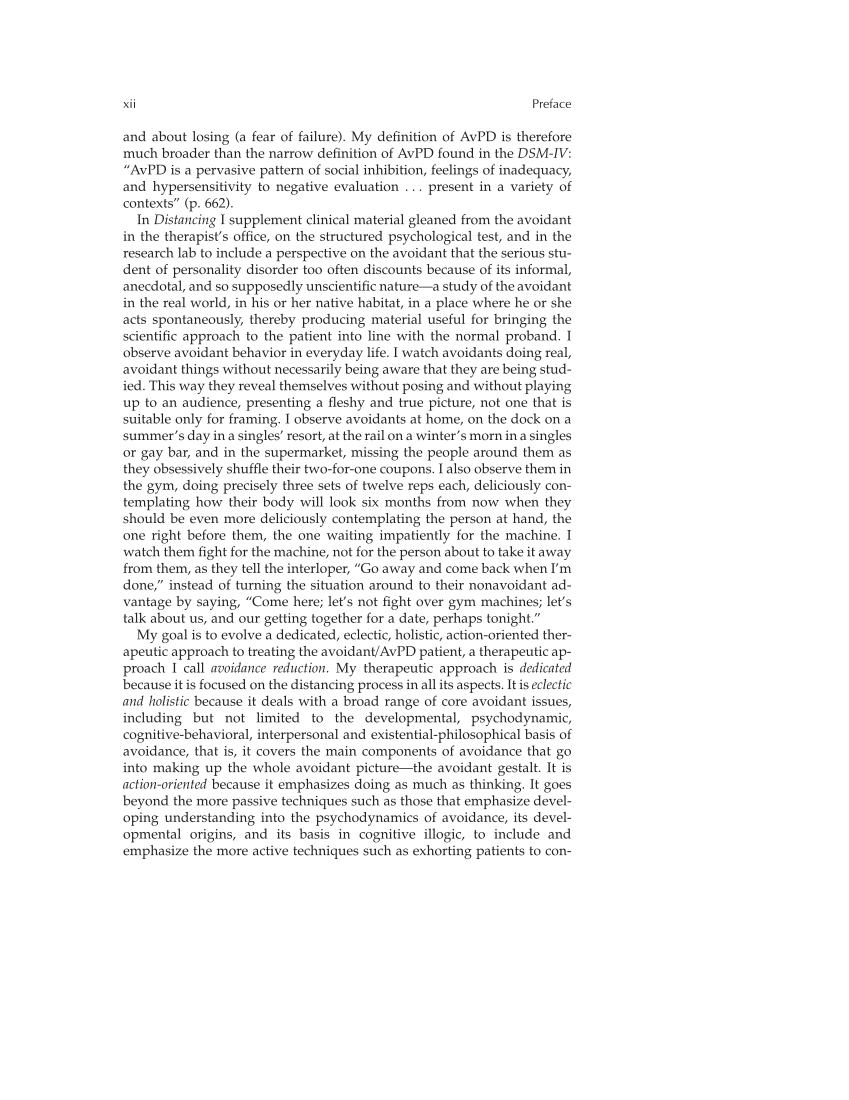Preface xii and about losing (a fear of failure). My definition of AvPD is therefore much broader than the narrow definition of AvPD found in the DSM-IV: “AvPD is a pervasive pattern of social inhibition, feelings of inadequacy, and hypersensitivity to negative evaluation . . . present in a variety of contexts” (p. 662). In Distancing I supplement clinical material gleaned from the avoidant in the therapist’s office, on the structured psychological test, and in the research lab to include a perspective on the avoidant that the serious stu- dent of personality disorder too often discounts because of its informal, anecdotal, and so supposedly unscientific nature—a study of the avoidant in the real world, in his or her native habitat, in a place where he or she acts spontaneously, thereby producing material useful for bringing the scientific approach to the patient into line with the normal proband. I observe avoidant behavior in everyday life. I watch avoidants doing real, avoidant things without necessarily being aware that they are being stud- ied. This way they reveal themselves without posing and without playing up to an audience, presenting a fleshy and true picture, not one that is suitable only for framing. I observe avoidants at home, on the dock on a summer’s day in a singles’ resort, at the rail on a winter’s morn in a singles or gay bar, and in the supermarket, missing the people around them as they obsessively shuffle their two-for-one coupons. I also observe them in the gym, doing precisely three sets of twelve reps each, deliciously con- templating how their body will look six months from now when they should be even more deliciously contemplating the person at hand, the one right before them, the one waiting impatiently for the machine. I watch them fight for the machine, not for the person about to take it away from them, as they tell the interloper, “Go away and come back when I’m done,” instead of turning the situation around to their nonavoidant ad- vantage by saying, “Come here let’s not fight over gym machines let’s talk about us, and our getting together for a date, perhaps tonight.” My goal is to evolve a dedicated, eclectic, holistic, action-oriented ther- apeutic approach to treating the avoidant/AvPD patient, a therapeutic ap- proach I call avoidance reduction. My therapeutic approach is dedicated because it is focused on the distancing process in all its aspects. It is eclectic and holistic because it deals with a broad range of core avoidant issues, including but not limited to the developmental, psychodynamic, cognitive-behavioral, interpersonal and existential-philosophical basis of avoidance, that is, it covers the main components of avoidance that go into making up the whole avoidant picture—the avoidant gestalt. It is action-oriented because it emphasizes doing as much as thinking. It goes beyond the more passive techniques such as those that emphasize devel- oping understanding into the psychodynamics of avoidance, its devel- opmental origins, and its basis in cognitive illogic, to include and emphasize the more active techniques such as exhorting patients to con-
Document Details My Account Print multiple pages
Print
You have printed 0 times in the last 24 hours.
Your print count will reset on at .
You may print 0 more time(s) before then.
You may print a maximum of 0 pages at a time.







































































































































































































































































































